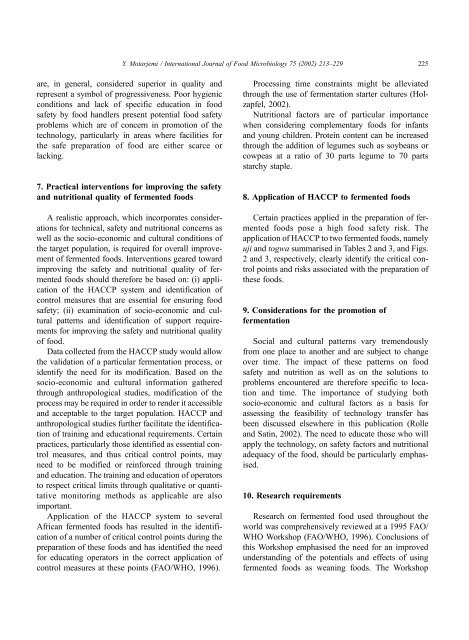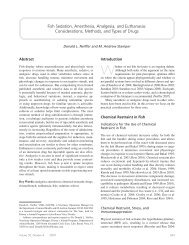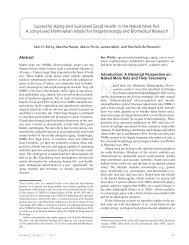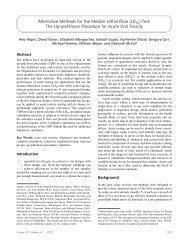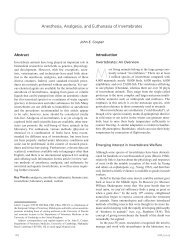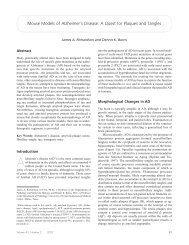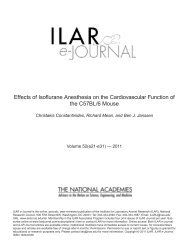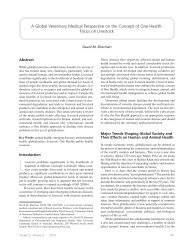Impact of small scale fermentation technology on food safety in ...
Impact of small scale fermentation technology on food safety in ...
Impact of small scale fermentation technology on food safety in ...
You also want an ePaper? Increase the reach of your titles
YUMPU automatically turns print PDFs into web optimized ePapers that Google loves.
Y. Motarjemi / Internati<strong>on</strong>al Journal <str<strong>on</strong>g>of</str<strong>on</strong>g> Food Microbiology 75 (2002) 213–229 225<br />
are, <strong>in</strong> general, c<strong>on</strong>sidered superior <strong>in</strong> quality and<br />
represent a symbol <str<strong>on</strong>g>of</str<strong>on</strong>g> progressiveness. Poor hygienic<br />
c<strong>on</strong>diti<strong>on</strong>s and lack <str<strong>on</strong>g>of</str<strong>on</strong>g> specific educati<strong>on</strong> <strong>in</strong> <strong>food</strong><br />
<strong>safety</strong> by <strong>food</strong> handlers present potential <strong>food</strong> <strong>safety</strong><br />
problems which are <str<strong>on</strong>g>of</str<strong>on</strong>g> c<strong>on</strong>cern <strong>in</strong> promoti<strong>on</strong> <str<strong>on</strong>g>of</str<strong>on</strong>g> the<br />
<str<strong>on</strong>g>technology</str<strong>on</strong>g>, particularly <strong>in</strong> areas where facilities for<br />
the safe preparati<strong>on</strong> <str<strong>on</strong>g>of</str<strong>on</strong>g> <strong>food</strong> are either scarce or<br />
lack<strong>in</strong>g.<br />
7. Practical <strong>in</strong>terventi<strong>on</strong>s for improv<strong>in</strong>g the <strong>safety</strong><br />
and nutriti<strong>on</strong>al quality <str<strong>on</strong>g>of</str<strong>on</strong>g> fermented <strong>food</strong>s<br />
A realistic approach, which <strong>in</strong>corporates c<strong>on</strong>siderati<strong>on</strong>s<br />
for technical, <strong>safety</strong> and nutriti<strong>on</strong>al c<strong>on</strong>cerns as<br />
well as the socio-ec<strong>on</strong>omic and cultural c<strong>on</strong>diti<strong>on</strong>s <str<strong>on</strong>g>of</str<strong>on</strong>g><br />
the target populati<strong>on</strong>, is required for overall improvement<br />
<str<strong>on</strong>g>of</str<strong>on</strong>g> fermented <strong>food</strong>s. Interventi<strong>on</strong>s geared toward<br />
improv<strong>in</strong>g the <strong>safety</strong> and nutriti<strong>on</strong>al quality <str<strong>on</strong>g>of</str<strong>on</strong>g> fermented<br />
<strong>food</strong>s should therefore be based <strong>on</strong>: (i) applicati<strong>on</strong><br />
<str<strong>on</strong>g>of</str<strong>on</strong>g> the HACCP system and identificati<strong>on</strong> <str<strong>on</strong>g>of</str<strong>on</strong>g><br />
c<strong>on</strong>trol measures that are essential for ensur<strong>in</strong>g <strong>food</strong><br />
<strong>safety</strong>; (ii) exam<strong>in</strong>ati<strong>on</strong> <str<strong>on</strong>g>of</str<strong>on</strong>g> socio-ec<strong>on</strong>omic and cultural<br />
patterns and identificati<strong>on</strong> <str<strong>on</strong>g>of</str<strong>on</strong>g> support requirements<br />
for improv<strong>in</strong>g the <strong>safety</strong> and nutriti<strong>on</strong>al quality<br />
<str<strong>on</strong>g>of</str<strong>on</strong>g> <strong>food</strong>.<br />
Data collected from the HACCP study would allow<br />
the validati<strong>on</strong> <str<strong>on</strong>g>of</str<strong>on</strong>g> a particular <str<strong>on</strong>g>fermentati<strong>on</strong></str<strong>on</strong>g> process, or<br />
identify the need for its modificati<strong>on</strong>. Based <strong>on</strong> the<br />
socio-ec<strong>on</strong>omic and cultural <strong>in</strong>formati<strong>on</strong> gathered<br />
through anthropological studies, modificati<strong>on</strong> <str<strong>on</strong>g>of</str<strong>on</strong>g> the<br />
process may be required <strong>in</strong> order to render it accessible<br />
and acceptable to the target populati<strong>on</strong>. HACCP and<br />
anthropological studies further facilitate the identificati<strong>on</strong><br />
<str<strong>on</strong>g>of</str<strong>on</strong>g> tra<strong>in</strong><strong>in</strong>g and educati<strong>on</strong>al requirements. Certa<strong>in</strong><br />
practices, particularly those identified as essential c<strong>on</strong>trol<br />
measures, and thus critical c<strong>on</strong>trol po<strong>in</strong>ts, may<br />
need to be modified or re<strong>in</strong>forced through tra<strong>in</strong><strong>in</strong>g<br />
and educati<strong>on</strong>. The tra<strong>in</strong><strong>in</strong>g and educati<strong>on</strong> <str<strong>on</strong>g>of</str<strong>on</strong>g> operators<br />
to respect critical limits through qualitative or quantitative<br />
m<strong>on</strong>itor<strong>in</strong>g methods as applicable are also<br />
important.<br />
Applicati<strong>on</strong> <str<strong>on</strong>g>of</str<strong>on</strong>g> the HACCP system to several<br />
African fermented <strong>food</strong>s has resulted <strong>in</strong> the identificati<strong>on</strong><br />
<str<strong>on</strong>g>of</str<strong>on</strong>g> a number <str<strong>on</strong>g>of</str<strong>on</strong>g> critical c<strong>on</strong>trol po<strong>in</strong>ts dur<strong>in</strong>g the<br />
preparati<strong>on</strong> <str<strong>on</strong>g>of</str<strong>on</strong>g> these <strong>food</strong>s and has identified the need<br />
for educat<strong>in</strong>g operators <strong>in</strong> the correct applicati<strong>on</strong> <str<strong>on</strong>g>of</str<strong>on</strong>g><br />
c<strong>on</strong>trol measures at these po<strong>in</strong>ts (FAO/WHO, 1996).<br />
Process<strong>in</strong>g time c<strong>on</strong>stra<strong>in</strong>ts might be alleviated<br />
through the use <str<strong>on</strong>g>of</str<strong>on</strong>g> <str<strong>on</strong>g>fermentati<strong>on</strong></str<strong>on</strong>g> starter cultures (Holzapfel,<br />
2002).<br />
Nutriti<strong>on</strong>al factors are <str<strong>on</strong>g>of</str<strong>on</strong>g> particular importance<br />
when c<strong>on</strong>sider<strong>in</strong>g complementary <strong>food</strong>s for <strong>in</strong>fants<br />
and young children. Prote<strong>in</strong> c<strong>on</strong>tent can be <strong>in</strong>creased<br />
through the additi<strong>on</strong> <str<strong>on</strong>g>of</str<strong>on</strong>g> legumes such as soybeans or<br />
cowpeas at a ratio <str<strong>on</strong>g>of</str<strong>on</strong>g> 30 parts legume to 70 parts<br />
starchy staple.<br />
8. Applicati<strong>on</strong> <str<strong>on</strong>g>of</str<strong>on</strong>g> HACCP to fermented <strong>food</strong>s<br />
Certa<strong>in</strong> practices applied <strong>in</strong> the preparati<strong>on</strong> <str<strong>on</strong>g>of</str<strong>on</strong>g> fermented<br />
<strong>food</strong>s pose a high <strong>food</strong> <strong>safety</strong> risk. The<br />
applicati<strong>on</strong> <str<strong>on</strong>g>of</str<strong>on</strong>g> HACCP to two fermented <strong>food</strong>s, namely<br />
uji and togwa summarised <strong>in</strong> Tables 2 and 3, and Figs.<br />
2 and 3, respectively, clearly identify the critical c<strong>on</strong>trol<br />
po<strong>in</strong>ts and risks associated with the preparati<strong>on</strong> <str<strong>on</strong>g>of</str<strong>on</strong>g><br />
these <strong>food</strong>s.<br />
9. C<strong>on</strong>siderati<strong>on</strong>s for the promoti<strong>on</strong> <str<strong>on</strong>g>of</str<strong>on</strong>g><br />
<str<strong>on</strong>g>fermentati<strong>on</strong></str<strong>on</strong>g><br />
Social and cultural patterns vary tremendously<br />
from <strong>on</strong>e place to another and are subject to change<br />
over time. The impact <str<strong>on</strong>g>of</str<strong>on</strong>g> these patterns <strong>on</strong> <strong>food</strong><br />
<strong>safety</strong> and nutriti<strong>on</strong> as well as <strong>on</strong> the soluti<strong>on</strong>s to<br />
problems encountered are therefore specific to locati<strong>on</strong><br />
and time. The importance <str<strong>on</strong>g>of</str<strong>on</strong>g> study<strong>in</strong>g both<br />
socio-ec<strong>on</strong>omic and cultural factors as a basis for<br />
assess<strong>in</strong>g the feasibility <str<strong>on</strong>g>of</str<strong>on</strong>g> <str<strong>on</strong>g>technology</str<strong>on</strong>g> transfer has<br />
been discussed elsewhere <strong>in</strong> this publicati<strong>on</strong> (Rolle<br />
and Sat<strong>in</strong>, 2002). The need to educate those who will<br />
apply the <str<strong>on</strong>g>technology</str<strong>on</strong>g>, <strong>on</strong> <strong>safety</strong> factors and nutriti<strong>on</strong>al<br />
adequacy <str<strong>on</strong>g>of</str<strong>on</strong>g> the <strong>food</strong>, should be particularly emphasised.<br />
10. Research requirements<br />
Research <strong>on</strong> fermented <strong>food</strong> used throughout the<br />
world was comprehensively reviewed at a 1995 FAO/<br />
WHO Workshop (FAO/WHO, 1996). C<strong>on</strong>clusi<strong>on</strong>s <str<strong>on</strong>g>of</str<strong>on</strong>g><br />
this Workshop emphasised the need for an improved<br />
understand<strong>in</strong>g <str<strong>on</strong>g>of</str<strong>on</strong>g> the potentials and effects <str<strong>on</strong>g>of</str<strong>on</strong>g> us<strong>in</strong>g<br />
fermented <strong>food</strong>s as wean<strong>in</strong>g <strong>food</strong>s. The Workshop


